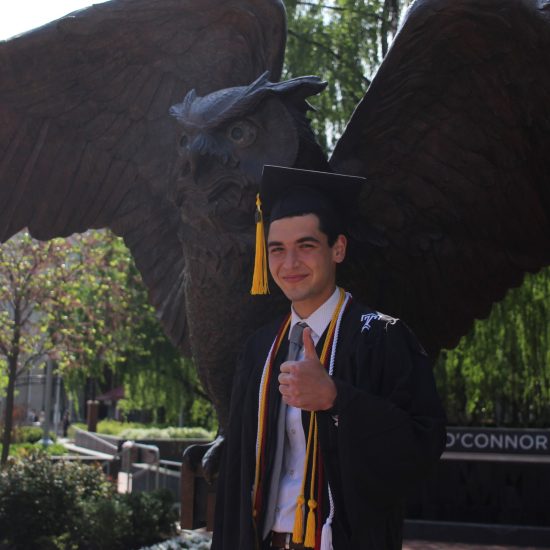Formerly the #3 prospect in baseball and the most heralded Angels prospect since Mike Trout, Jo Adell has had a nightmarish start to his career. Adell was tossed into a trial-by-fire during the 2020 pandemic-shortened season. The Angels decided to have him face major league pitching after a total of just 270 career ABs between AA and AAA, which resulted in a .161/.212/.266 MLB slash line and a Jose Canseco-style defensive gaffe.
In 2021, after it was clear Adell wasn’t ready for The Show, the Halos sent him back to AAA-Salt Lake for 311 ABs and then called him up for 130 more MLB ABs after the playoff race was over. Adell upped his game a bit in that second “cup of coffee,” slashing .246/.295/.408. That sample, along with his prior prospect pedigree, was enough to get managers excited for 2022. If he could just cut down a little more on swings and misses and clean up some holes in his swing, the thought was Adell could convert that incredible 70-grade raw power into 70-grade game power. Then, he’d be a real force at the plate.
Unfortunately for Adell, most of the improvements he made in 2021 went completely out the window in 2022:
With ugly walk and strikeout percentages, it’s no wonder Adell couldn’t get anything going at the plate. The swing-and-miss has always been part of Adell’s game, with scouts noting as such in his pre-draft evaluation, but 2022 represented a bottoming out for him, as Adell simply whiffed more than ever. Pitchers of all caliber feasted on Adell’s weaknesses at the plate in 2022, turning whatever confidence he might have had in his game into mush.
Thanks to the Angels conducting a “disaster class” in his development, Adell has gone from potential co-savior of a beleaguered franchise to likely bust, and has watched less-heralded prospects like Taylor Ward cannibalize his potential playing time–and deservedly so.
But it’s not all doom and gloom for Adell. He may never be the next great Angels OF, especially with how often he whiffs. But his high-end speed and power show that he still has the potential to provide valuable contributions at the plate and in the outfield. He’s got to make more contact to be that guy, but he’s shooting himself in the foot with his approach.
Adell is Swinging at Almost Everything
Some players like to swing at everything that comes their way. After all — the thinking goes — if you swing early in counts, chances are that you’re likely to get something to hit, since pitchers are more inclined to throw strikes. The earlier in the AB you swing, the more likely you’ll be swinging at a hittable pitch, right? Not quite.
In fact, it’s very difficult to provide positive run value on every swing. In the graph below, only a small handful of players provide positive value on their swings:
Career Run Value on Swings/Takes, since 1988
Barry Bonds not only has the most offense generated base on his swings, but also his takes. He's incomparable.
There are very few players who have a positive contribution with their swings. pic.twitter.com/3XsZrPwzWu
— Tangotiger 🍁 (@tangotiger) February 25, 2022
In fact, it’s been found that swinging at more strikes negatively correlates with outcomes. So, even when the batter swings at the pitches that are generally easier to hit, the batter isn’t likely to produce positive run value. Accordingly, it behooves most batters to swing less, not more, at the plate.
Adell was one of the most frequent free-swinging players in baseball last season. Among players with at least 150 PAs, Adell ranked 91st out of 417 eligible batters, offering at roughly 52% of all pitches seen. He was also less likely to make pitchers earn their strikes, as only 15.3% of Adell’s total strikes were called strikes, ranking 257th of 417 eligible batters. And remember, a significant amount of those called strikes come in 0-0 counts, since he’s not swinging much to start his at-bats.
Adell’s Swing% isn’t the sole contributor to his woes in terms of strikes. Players swinging at comparable rates to Adell but producing far more favorable outcomes include Kyle Tucker (77th, 52.6% swing), Austin Riley (100th, 51.5%), and Cedric Mullins (109th, 51.3%). One of the main differences between Adell and the aforementioned group is that Adell is swinging at more balls, not strikes:
In fact, Adell is swinging at over half of his pitches, and more than a third of the pitches outside the zone, essentially gifting opposing pitchers easy strikes in his at-bats. While Tucker and Adell swing at similar rates, Tucker is swinging at pitches in the zone and turning them into positive outcomes, whereas Adell is attempting to hit just about every pitch he sees, regardless of its location. But he didn’t always have such a free-swinging nature.
As the season progressed, with Adell coming back up to the Angels after a month-long stint with Triple-A Salt Lake, he began swinging frequently at pitches he shouldn’t:
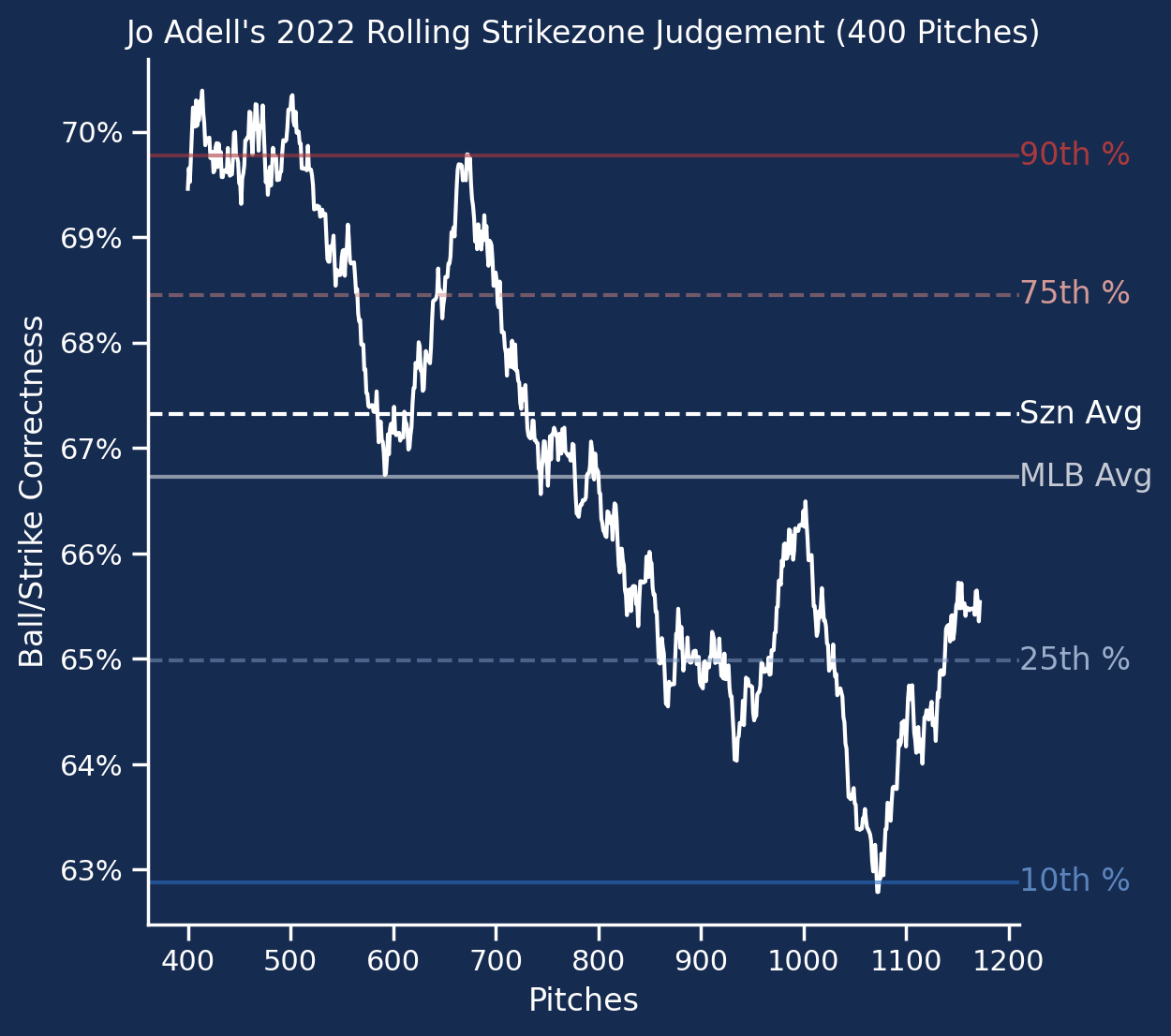
The “correctness” of Adell’s swings and takes, based on the likelihood of a pitch being a called strike or a ball. Courtesy of PLV at PitcherList.
By swinging at so many expected balls, Adell was setting himself up for pitcher-favored counts, like 1-2 and 0-2. In those counts, pitchers are likely to throw their “out” pitches, which are extremely difficult to hit, relative to their other offerings. Accordingly, hitters struggle to produce anywhere close to league-average in pitcher-favored counts like 0-2, producing just a .203 wOBA in those situations. With how frequently he swung at low-quality pitches, it’s no wonder that Adell struggled out to an even worse slash line in the second half:
Some of this could have been Adell “pressing” at the plate, trying to show that he belonged with the big league club after expressing frustration for being sent back to Triple-A to rework his approach. Pressing often leads to non-competitive swings and outs, since the player is trying to go for the “home run swing” as opposed to utilizing the approach that has made them successful.
Also likely: in the second half, pitchers were armed with more film and data on Adell and started throwing him pitches he had a tendency to chase, digging him deep into unfavorable counts. Adell was one of the worst players in baseball against pitches BaseballSavant deemed “chase” pitches (at least a full baseball outside the strike zone in every direction) indicating that Adell simply couldn’t hit those pitches and couldn’t resist chasing after them. In the second half, with Adell swinging at ugly pitches more than anyone in baseball, it might have been as simple as Adell just swinging less overall.
…Just Not First-Pitch Strikes
There is a catch, though. If pitchers think the batter isn’t likely to swing at the first pitch, they can try to get ahead of batters by tossing a strike to push the count into their favor. There is a marked difference in results between even 0-1 and 1-0 counts, as hitters produced a .270 wOBA on outcomes produced after 0-1 and .363 after 1-0. The difference in wOBA deepens as the count changes, as a 3-0 count is dramatically more productive overall (.544) than an 0-2 count (.203). The hitters who get to 3-0 counts more frequently produce favorable outcomes, as they’re either seeing pitches to hit or getting walked.
One factor contributing to Adell’s plate discipline issues is that he’s relatively prudent with his first-pitch swings, meaning that most of his swings are coming later in counts. He’s seeing a called strike in 34% of plate appearances, ranking in the upper third of the league (104th of 367 hitters with 1,000 pitches seen). He wasn’t particularly aggressive last season on 0-0 counts, choosing to swing a little less at pitches he might be expected to swing at in 0-0 counts:
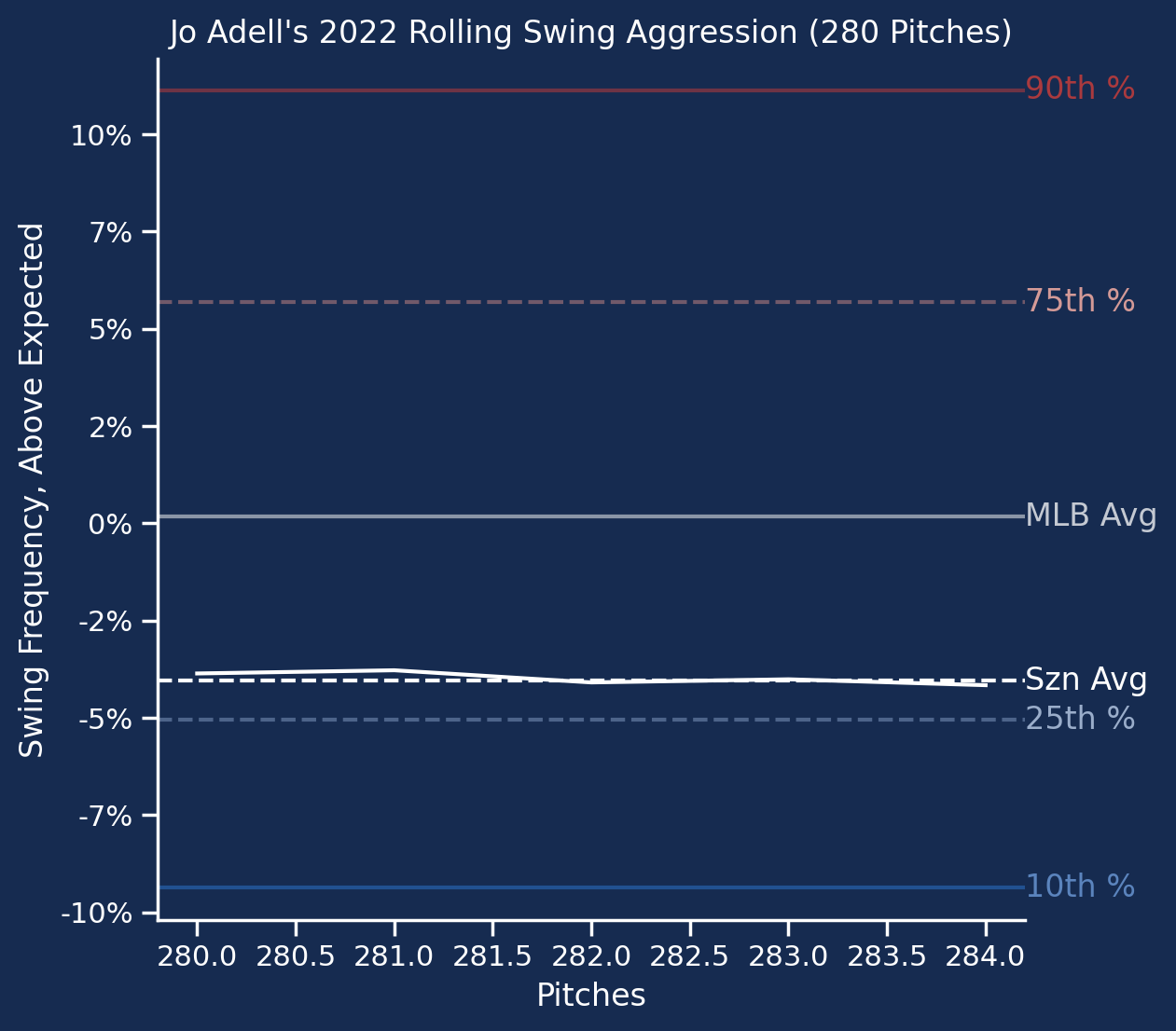
It seems that he’s seeing a lot of called strikes go by, which we know can significantly alter the story of a plate appearance. But it’s not like Adell is taking these pitches because he’s getting ugly junk pitches that drop in for strikes. Pitchers are tossing called first strikes over the “heart” (per BaseballSavant’s definition) of the plate in over half of Adell’s first-pitch strike calls, which is well above average. So, Adell is watching good, positive-outcome-producing pitches go by to start his at-bats fairly often, and he could benefit from simply swinging just a little more often to let pitchers know that he’s not afraid to swing at the good stuff!
When paired with his true first-pitch strike percentage, which subtracts balls put into play on 0-0 counts and measures only the amount of times a hitter reaches an 0-1 count — essentially, we’re counting his foul balls and swinging strikes now — Adell is getting to that 0-1 count in 53.3% (95th among 417 hitters with 150+ PAs) of plate appearances. He’s reaching 0-1 in part because he’s swinging and missing or fouling balls off, of course, but the biggest driver behind his 0-1 counts is taking just a few too many called strikes. Falling behind in the count in over 60% of at-bats is not a recipe for success for most hitters not named Juan Soto.
Pitchers recognize that Adell’s not going to swing very often, so they’re willing to toss in easier strikes early in the count. So, to keep pitchers on their toes, Adell should be looking just a little more often for pitches early in the count, so that he can either get a nice pitch to hit or put the pitcher behind in the count early if the pitch isn’t good.
But Once Adell Gets Down in the Count…
While he’s perfectly content to “wait for his pitch” to open the at-bat, Adell doesn’t seem to be comfortable waiting to swing deeper in counts, which — if he swings and misses — gets him to 2-strike counts quickly and more frequently than the average hitter. Take a look at Adell’s approach numbers in 2022, which indicate his propensity to get into pitcher’s counts:

Adell is well above-average in terms of 2-strike count percentage, thanks in part to aggressive swinging and in part to some issues with pitch recognition (more on that later). Remember, he was in the top 10% of players in terms of swinging strike percentage in 1-strike counts (0-1, 1-1, 2-1, etc.), so it should come as no surprise then that Adell ranked 10th among all batters with at least 150 PAs in terms of pitches seen with two strikes. And, when a favorable count is so critical to producing hitter success, getting to those two-strike counts is not ideal for positive production.
So, what gives? Why is Adell swinging and missing so often once he’s deeper into the count?
Let’s take a closer look at Adell’s pitch heat map on 0-1 to see where pitchers are “hitting” him hardest.
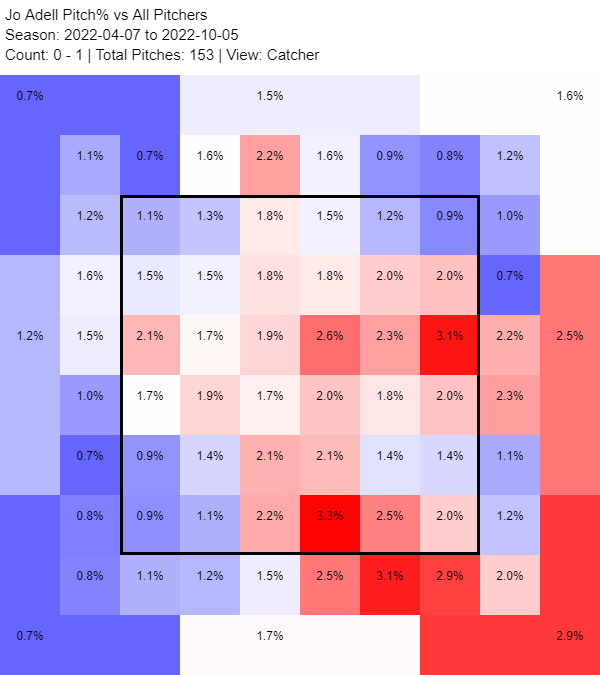
Jo Adell’s Pitch% on 0-1 counts in 2022, courtesy of Fangraphs.
A significant percentage of Adell’s overall pitches are in that lower right corner of the strike zone and beyond. Among all players with 250+ plate appearances in 2022, Adell was in the top 40 (89th percentile) for the percentage of pitches — not discriminating based on count — thrown in that bottom-right corner.
More broadly, pitchers are tossing him a ton of stuff outside or on the outer half of the plate on 0-1 pitches. Now, it’s not a problem that Adell sees a lot of those pitches if he lays off of them. However, Adell isn’t laying off those pitches enough, relative to his peers:
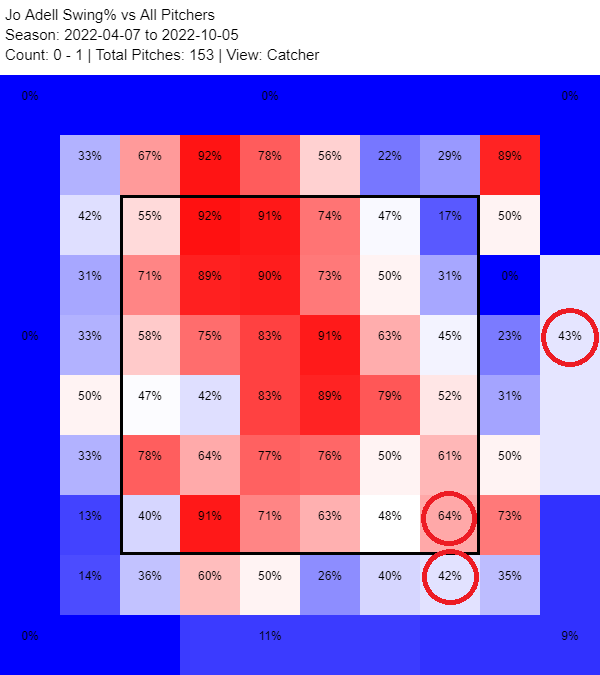
Adell’s Swing% in 0-1 counts in 2022, courtesy of Fangraphs
A couple areas to look out for include the circled 43% swing percentage on pitches in the middle horizontally, but at least a full baseball off the right side of the plate, the 42% swing percentage on pitches that are just below the strike zone, and the 64% swing percentage box just above it. These are not pitches that turn into positive outcomes often, even when hit, because they can easily turn into weakly-hit pulled balls to left or pitches that are poked or flared to the opposite field.
On those same 0-1 pitches, using the boxes pointed out above, Adell is having some success putting his bat on the ball:
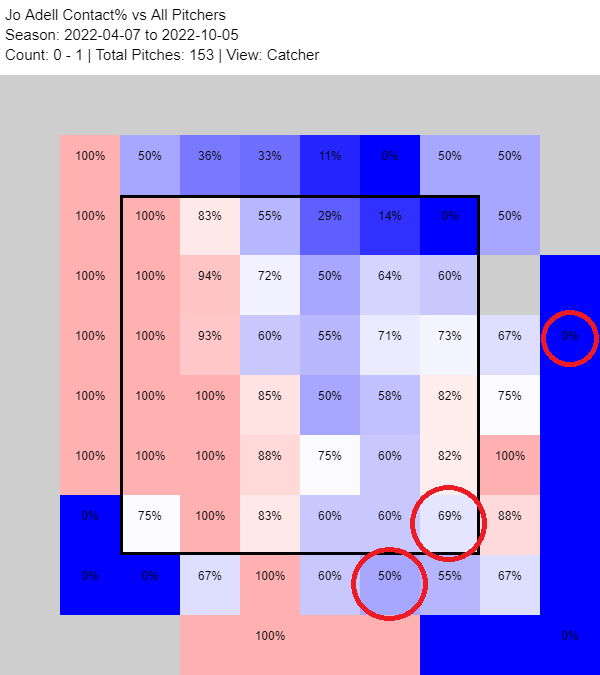
Adell’s Contact% in 0-1 counts in 2022, courtesy of Fangraphs
But in those areas where he’s seeing a lot of pitches or swinging often, like the ones circled, Adell isn’t getting the bat on the ball enough to produce positive outcomes. He’s still swinging enough at these pitches that pitchers will test him, but he’s making contact at below-average rates on those pitches, which is bad news for his batting average, slugging percentage, and isolated power on those pitches, among other things.
When Adell swings at these pitches that are unlikely to turn into strikes, he’s once again digging himself into a hole where pitchers can test him with “junk” pitches and borderline strikes that are extremely difficult to hit. Take a look at this pitch, which would probably fit into the 73% swing box off to the bottom of the plate. How on Earth is anyone supposed to hit these kinds of pitches?
https://gfycat.com/relievedwetherculesbeetle
To be sure, Acevedo throws him a nasty pitch here (and it’s an 0-2 pitch, not 0-1, but ignore that), but this result became all too common for Adell last season. Pitchers figured out that these low pitches were Adell’s kryptonite, as he saw nearly half of his pitches in 2022 at the bottom of the strike zone or below, well above league average in terms of pitch location. However, Adell wasn’t seeing pitches like Acevedo’s nearly as often; in fact, Adell saw pitches located on the outside of the plate at one of the lowest rates in the league. So, when pitchers threw him those sliders low and away — he saw a steady diet of sliders in 2022, nearly a quarter of all his pitches — Adell couldn’t turn them into anything productive. They became his “out pitch,” as Adell ranked as one of the worst hitters against sliders in 2022 among batters with at least 250+ PAs.
Most generally, Adell could benefit from simply laying off these sliders down and away a little more often. Those are difficult pitches to lay off — if it were that simple, we’d never need to tell players to lay off them — but Adell’s swing as currently constructed can’t catch up to those pitches most times, and so he’s either weakly making contact with them, or not making contact at all. More specifically, Adell should be on the lookout for some pitches low and away later in counts because pitchers tested him all the time with that pitch in 2022 and got away with it. If he could just learn to recognize those sliders more often…
In 2-Strike Counts, Adell Tightens Up
Now, there aren’t many batters who are “good” in 2-strike counts, but Adell wasn’t such a slouch when it came to those counts relative to his peers. Remember, batters want to avoid getting into 2-strike counts in general, since they’re not very likely to produce positive outcomes, but if there was a count that went to 2 strikes in 2022, Adell wasn’t such a bad option. In fact, in counts that reached 0-2, Adell was 22nd among all batters in wRC+ produced and 21st in OPS.
But when we expand the inquiry to all 2-strike counts, regardless of whether the count is 0-2 or 3-2 or anything in between, Adell’s performance took a bit of a nosedive:
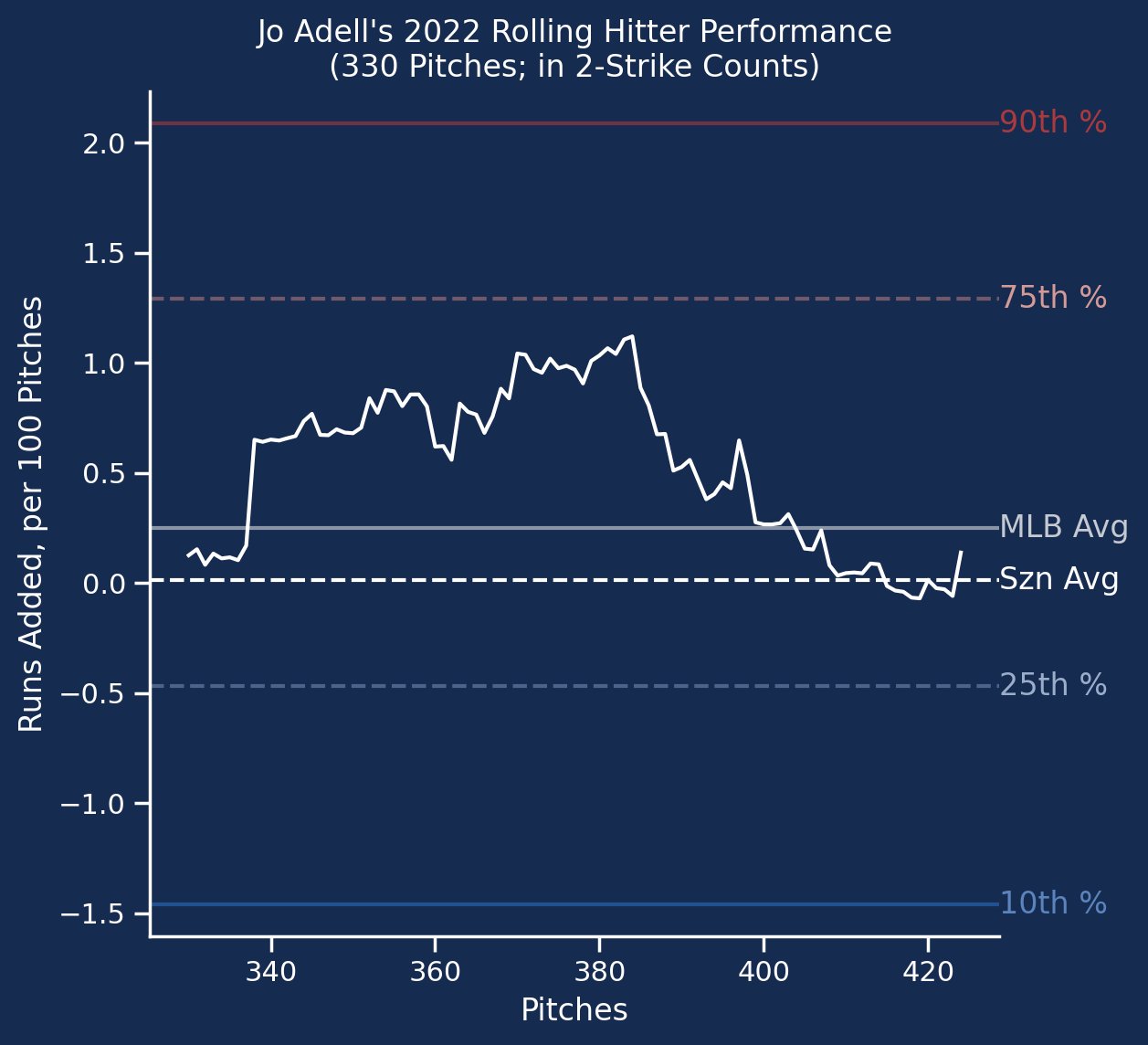
Adell’s overall Hitter Performance in 2-strike counts, courtesy of PitcherList.
In 2-strike counts, Adell was performing quite well for a bit, then fell below the MLB average, but his overall season average puts him squarely in the middle of the pack in terms of runs added. Given what we’ve already seen of Adell — chasing bad pitches, striking out a ton, failing to make good contact — it’s a surprise that he’s managed to put together essentially a league-average performance in some of the toughest counts in baseball. So, why is he so successful when the odds are particularly stacked against him, and how can he improve?
Firstly, he tightens up his swings and takes with 2 strikes:
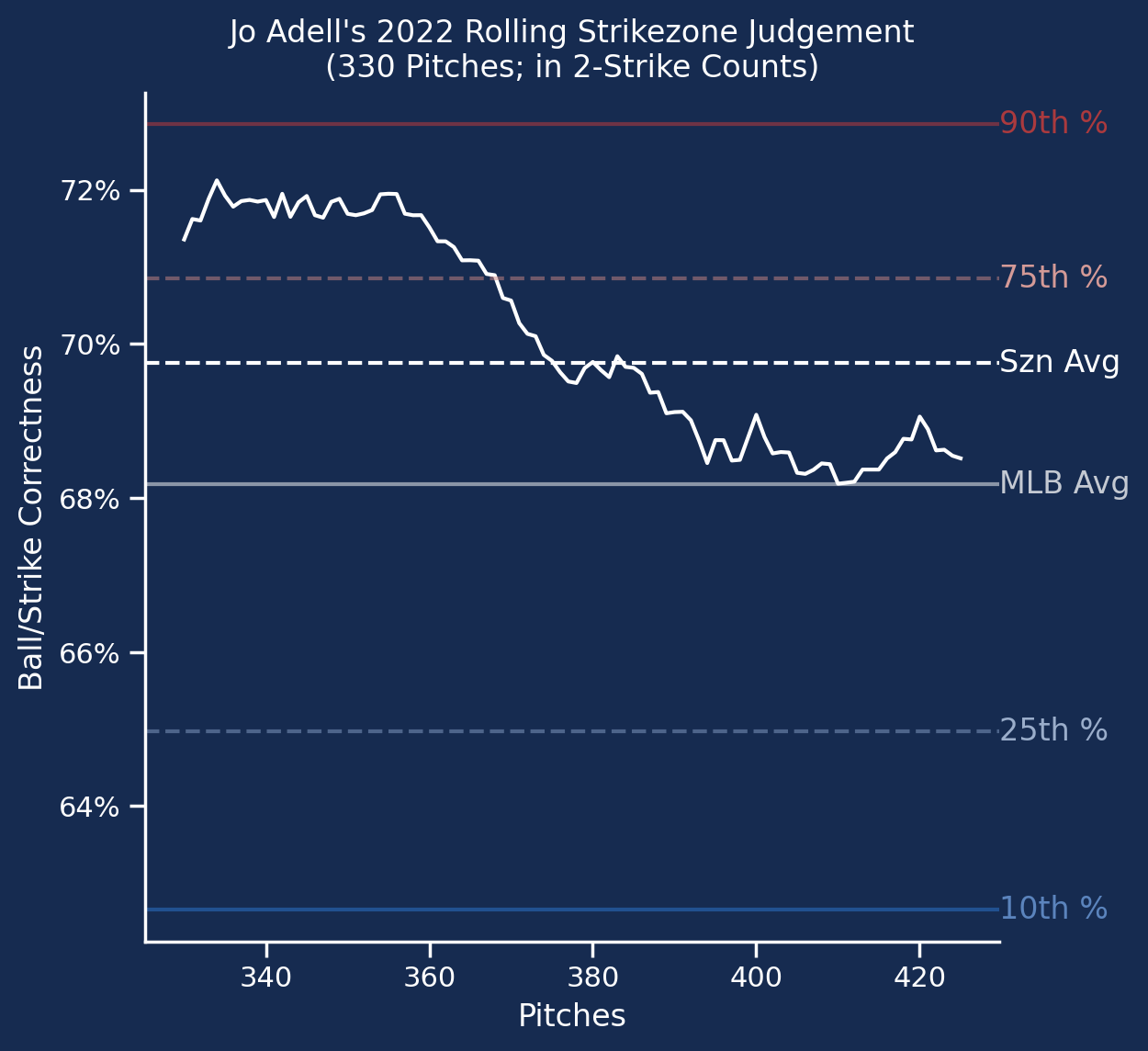
Courtesy of PitcherList’s PLV metrics.
Even as his strike zone judgment began to decline in the second half of the season, Adell was still above MLB average in terms of deciding whether pitches were balls or strikes in two-strike counts. This is particularly surprising because Adell’s strike zone judgment as a whole began to decline in the second half of the season, dipping well below MLB average as we saw above, but his two-strike count judgment remained above his peers. This is significant because when the batter is more prudent with their ball/strike judgments with 2 strikes, they are less likely to get themselves out and thus more likely to force a pitcher to make mistakes.
Adell also made smart decisions regarding when to swing or take with 2-strike counts, producing league-average or better decision value as his season progressed:
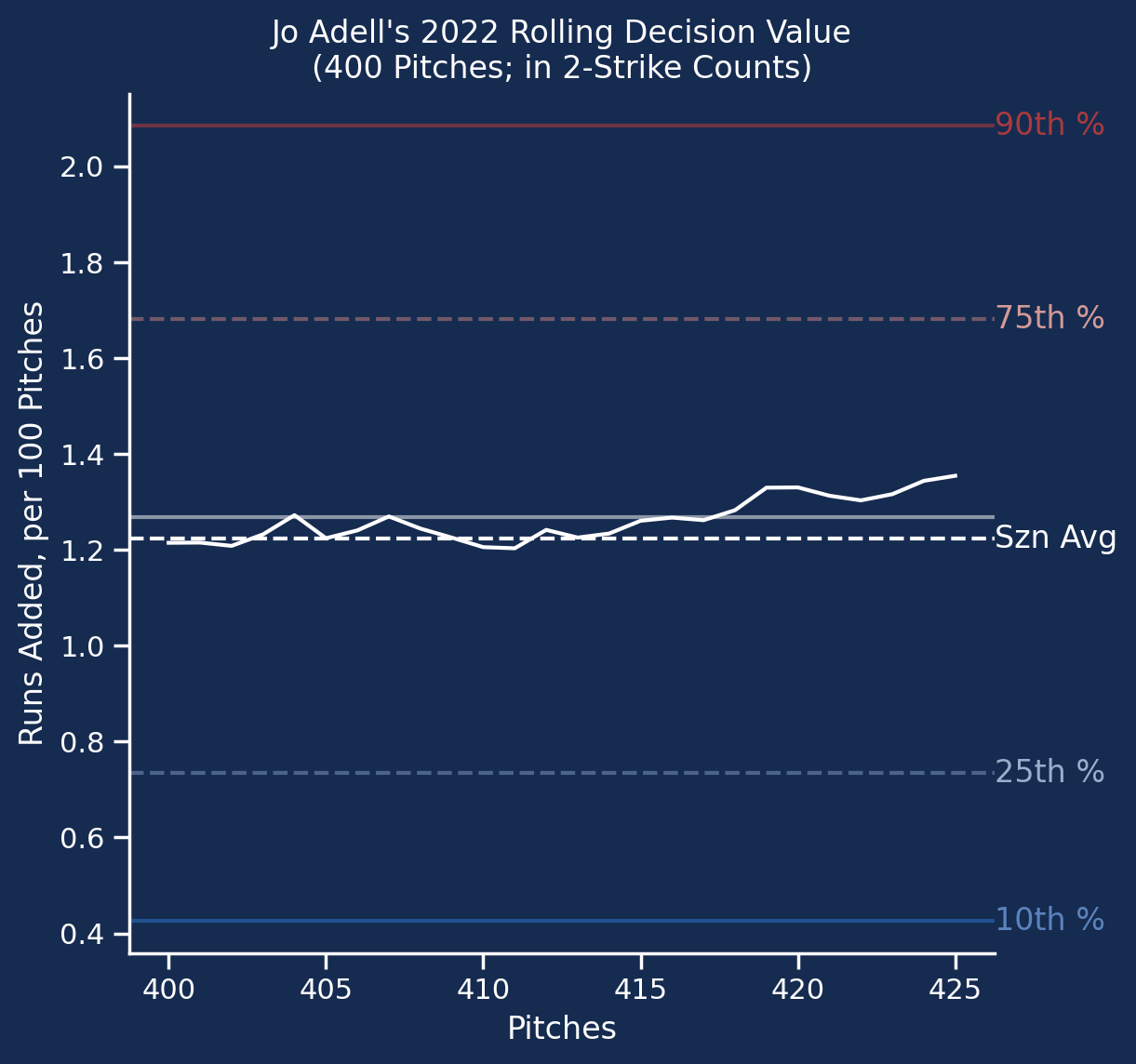
Jo Adell’s Rolling Decision Value in 2-strike counts, courtesy of PitcherList.
So, Adell was not only correctly judging his swings and takes at league-average or above rates, but he was also producing value above average in terms of swings and takes in 2-strike counts, meaning he was seeing the strike zone fairly well on 2-strike counts, and choosing to swing at the right times. Not too shabby, right? So, why was he among the league leaders in strikeouts with 2-strikes, despite possessing a fairly decent approach?
A Word of Caution: Adell isn’t Making Enough Contact
As we know already, Adell’s strike zone judgment isn’t terrible–it’s not great, but it’s certainly MLB serviceable. He can also certainly improve his performance by shoring up his approach early in counts and learning to stop chasing some tough pitches. However, his approach at the plate isn’t really what’s keeping him from turning into an MLB regular.
The thing that has hindered Adell’s growth the most is his swing and inability to make contact. As my colleague Kevin O’Brien astutely noted in last year’s Adell hype article, Adell tightened up his stance by standing more upright and bringing his hands and elbows tighter to his body. These adjustments created a more “compact” swing for Adell, so that he could theoretically get to the pitches up or down in the zone that require ultra-quick hands and speedy bat movement, the ones that seemed to beat him every time. He altered his swing a little further in 2022, maybe to finally get those finishing touches on his swing. However, it didn’t seem to bear out in his contact ability:
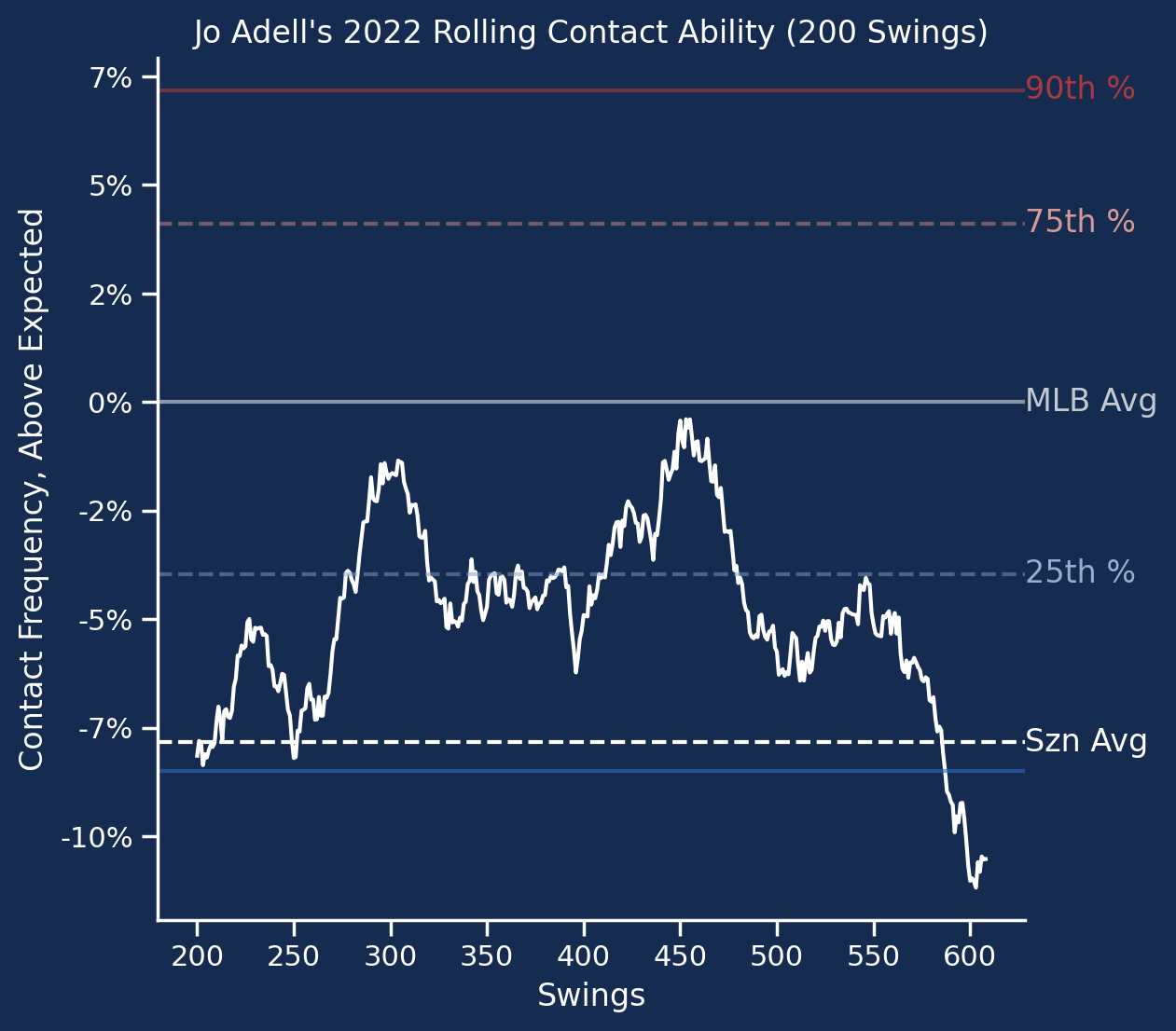
Adell’s Contact Ability in 2022, courtesy of PitcherList.
Adjustments or not, Adell is just simply not making enough contact to produce at the level managers are hoping for. His season average was just barely above the 10th percentile of MLB players, and dropped precipitously in that final stretch of the season, essentially hitting rock bottom. Other metrics seem to bear this out as well, as Adell ranked 19th among batters with 150+ PAs in Swinging Strike% and 13th in CSW, and boasted one of the league’s worst contact rates. He’s just not hitting the ball, and perhaps the best way to fix him is to continue fixing his swing.
Hopefully he’s found something at Driveline this offseason:
Angels MLB OF Jo Adell sitting around 110 EV off machine fastballs 😅 pic.twitter.com/KFzFdaVVVZ
— Driveline Baseball (@DrivelineBB) January 3, 2023
It’s nice to see Adell hit fastballs at 110+ EV, since he was hitting fastballs at one of the lowest EVs in the league in 2022 despite, by all accounts, boasting massive power. For a fellow who was projected at 70+ power by reputable prospect sources, it’s strange to see Adell in the same fastball EV range as contact-oriented hitters like Nick Madrigal and Steven Kwan, and average EV in the same range as Jake Cronenworth and Brandon Marsh, two players not known for boasting significant raw power.
But there should be some significant brakes-pumping, since Adell’s hitting these hard off of a machine throwing only fastballs. But it’s hard not to dream about Adell finally fixing his swing with the help of the Driveline team. Adell still hasn’t leveraged his power into strong in-game results, making solid contact on just 3% of his balls in play (among the worst in baseball) and hitting the ball weakly quite a bit (top third of the league), and maybe the Driveline team has helped him get there. There’s not much evidence to suggest that Adell’s even going to make a swing change yet, nor that this work at Driveline will help him get that awful contact ability up to a more respectable threshold, so it’s something to keep an eye on in Spring Training this season. Adell should be kept on waiver wire watch lists or reserved for late-draft flier status until there’s tangible improvement in his approach or his swing.
Conclusion
Adell can help his approach in two significant ways: swinging a bit more on the first pitch and laying off the down-and-away sliders that pitchers love to throw him. Swinging more at first pitches will help him capitalize on the clear strikes pitchers continue to lob him to open at-bats. Laying off the down-and-away sliders will limit his weak contact and put him in more favorable counts. Adell should be looking to avoid 2-strike counts more often, instead of following in fellow Halos’ leads and taking lots of pitches to open at-bats.
However, the biggest thing holding him back is his contact ability. Adell needs to retool his swing or improve his pitch recognition further to really take the next step into MLB success. Without it, Adell is going to struggle to catch up to pitches he knows are strikes and will fail to fend off the pitches he’s chasing out of the zone. With his winter work at Driveline, one can hope that Adell has turned a little bit of a corner with his contact ability, but it remains to be seen whether those improvements will stick once the games are played. Adell shouldn’t be at the top of fantasy managers’ waiver wire watch lists, but he should be on them, because a few changes to his approach and swing could eventually make him an MLB regular.
Article Featured Image by Doug Carlin (@bdougals on Twitter)

